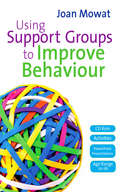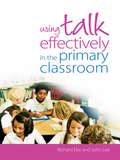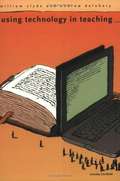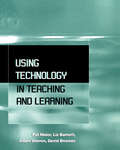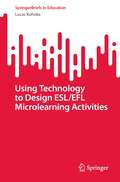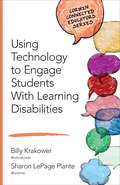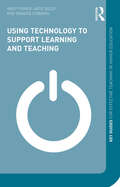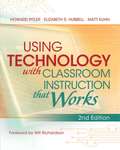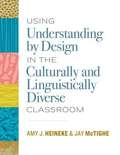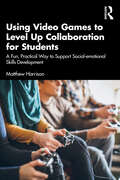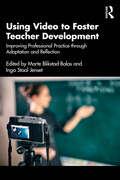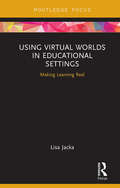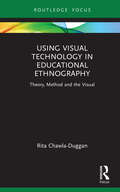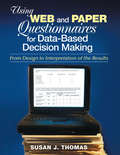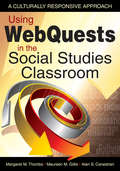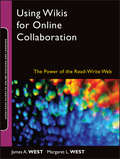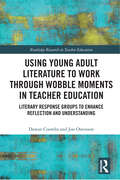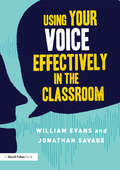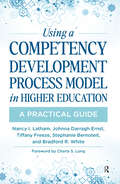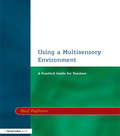- Table View
- List View
Using Support Groups to Improve Behaviour
by Joan MowatIncludes CD-Rom `Joan Mowat adapts ideas about understanding, transfer of learning, and theories of mind to help restless students deal better with their responsibilities toward others and themselves′ - Professor David Perkins, Graduate School of Education, Harvard University ′Mowat provides a valuable and comprehensive guide to the setting up, running and management of Support Groups as a whole-school initiative...This book would make an invaluable hand-book for anybody in a pastoral leadership role, who is interested in the organisation and setting up of support groups within a social setting′ - TES Website Based on material that has been successfully tried and tested, this book provides an example of a whole school approach to setting up and managing support groups to improve the behaviour of pupils with social, emotional and behavioural difficulties. Suitable for both primary and secondary schools, the strategies in the book align with the aims of the new Primary National Strategy and Key Stage 3 Strategy on behaviour and attendance, as well as the SEAL (Social and Emotional Aspects of Learning) curriculum, the Scottish ′Curriculum for Excellence′ and ′Happy, safe and achieving their potential′ (the standard of support for children and young people in Scottish schools). The book explains the aims of the support group approach, and gives practical advice on: - planning for and setting up a support group - involving parents in the process - assessing pupils′ progress - the role of the Support Group Leader - evaluating the implementations of the approach - how this approach supports new initiatives in behaviour & attendance. An accompanying CD contains everything necessary for implementing the approach outlined in the book, along with resources to support staff development. Teachers, Staff Development Co-ordinators, LEA Behaviour Support Teams, Teacher Educators, Student Teachers, Support for Learning and Pastoral Care Teachers will find this an excellent and useful resource. Joan Mowat is Lecturer in Education at the University of Strathclyde. She was previously a Deputy Headteacher in a secondary school, working with pupils with social, emotional and behavioural difficulties, and a former National Development Officer for the Scottish initiative ′Better Behaviour - Better Learning′. Joan offers CPD courses and consultancy to local authorities and schools and can be contacted at joan.mowat@strath.ac.uk
Using Talk Effectively in the Primary Classroom
by John Lee Richard EkeDrawing on their research into the quality, quantity and type of talk that happens in the everyday primary classroom, the authors offer insights into the most effective ways of using talk to improve teaching and learning. They consider broad classroom-based issues, such as: what is important about talk what children know about talk when they get to school the voice of authority and the voice of the learner whole class teaching for diversity the experience of boys and girls, and children with special needs using talk in the Literacy and Numeracy Hours using talk in science and ICT. Packed full of quotes from teachers and pupils in action, this innovative guide presents a range of practical ways that teachers can develop their interactions with their pupils to raise standards in all primary schools.
Using Talk to Support Writing
by Ros Fisher Shirley Larkin Debra Myhill Susan J. JonesUsing Talk to Support Writing presents a new and innovative approach to the teaching of early writing. The authors discuss both theoretical and practical issues around using talk in the classroom to support children as they learn to write. Set within the context of national concern for achievement in the development of writing ability, it addresses the gap in understanding early teaching and focuses on the exploration of how talk and writing interface. This includes: - Numerous examples of teaching and activities for using talk to support writing - Using extensive data from classrooms; video and audio recordings, and transcripts of children's talk - Exploring three aspects of talk when used to support writing: talk for idea generation; talk for oral rehearsal and talk for reflection. This book is for students on Primary ITT courses, particularly for English specialists. Students on M-level English and literacy courses will also find it useful.
Using Technology in Teaching
by William Clyde Andrew DeloheryComputers can help teachers accomplish many of their tasks more efficiently and effectively, but how can a time-strapped teacher determine which pieces of technology are likely to be most helpful? This easy-to-read book offers useful guidance for real-world situations. Organized around specific instructional goals (improving student writing, promoting collaborative learning) and commonly encountered tasks (communicating with students between class, distributing course materials), the book shows teachers at all instructional levels when and how technology can help them meet everyday challenges. Written in an anecdotal, non-technical style, the book and its accompanying CD-ROM cover how to use technology to: communicate with students distribute course materials promote collaborative learning learn through experience clarify course objectives improve student writing develop student research skills use assessment and feedback collect course materials identify plagiarism and more Teachers looking for tools to help them work better and more quickly will welcome this invaluable guide to the technology that will expedite their search.
Using Technology in Teaching and Learning
by Barnett, Liz Brunne, David Maier, Pal Warren, AdamFirst published in 1997. Routledge is an imprint of Taylor & Francis, an informa company.
Using Technology to Design ESL/EFL Microlearning Activities (SpringerBriefs in Education)
by Lucas KohnkeThis book provides strategies, tools, and best practices for incorporating microlearning in English language teaching. It aims to help teachers create and deliver microlearning mechanisms that are optimized for mobile learning. This book also draws on relevant literature and the author’s first-hand experience designing microlearning activities for English learners. It covers important aspects of microlearning, including artificial intelligence, virtual reality, augmented reality, and mixed modalities. It is an important starting point for teachers, academics, and researchers interested in the principles and practice of microlearning in English language teaching. English language teachers in formal and informal education environments find this work thought-provoking, instructive, and informative and benefit from exploring the possibilities of microlearning to motivate and engage learners and maximize the number and quality of their learning experiences.
Using Technology to Engage Students With Learning Disabilities (Corwin Connected Educators Series)
by William A. Krakower Sharon LePage PlanteLeverage technology to engage students with learning disabilities! Harness the power of today’s technology to improve learning and engagement for students with learning disabilities. By engaging students with learning disabilities using the technology already at your fingertips, you’ll see your students begin to thrive and grow in exciting new ways. In this volume in the Connected Educators Series, you’ll discover: New ideas for using assistive technology to teach core subjects and study skills How to build positive opportunities for students to show what they know Tools to provide better content accessibility How to help students connect and share through technology tools The Corwin Connected Educators series is your key to unlocking the greatest resource available to all educators: other educators. Being a Connected Educator is more than a set of actions: it’s a belief in the potential of technology to fuel lifelong learning. "Every educator can implement these methodologies to transform their learning environment into a place that honors and respects the differences of EVERY learner. Follow these simple steps: Read the book. Employ the content. Observe the successes. Then share those achievements with others!" Christopher R. Bugaj, Author and Presenter The Practical (and Fun) Guide to Assistive Technology in Public Schools "The authors have produced a practical approach to engaging students with learning disabilities. Educators will find great tools, ideas, and strategies to support students with learning challenges. Sprinkled throughout the book are case studies from noted educators, which are useful when thinking through the process of integrating technology in the classroom. This is a must read!" Brian S. Friedlander, Ph.D. AssistiveTek, LLC
Using Technology to Engage Students With Learning Disabilities (Corwin Connected Educators Series)
by William A. Krakower Sharon LePage PlanteLeverage technology to engage students with learning disabilities! Harness the power of today’s technology to improve learning and engagement for students with learning disabilities. By engaging students with learning disabilities using the technology already at your fingertips, you’ll see your students begin to thrive and grow in exciting new ways. In this volume in the Connected Educators Series, you’ll discover: New ideas for using assistive technology to teach core subjects and study skills How to build positive opportunities for students to show what they know Tools to provide better content accessibility How to help students connect and share through technology tools The Corwin Connected Educators series is your key to unlocking the greatest resource available to all educators: other educators. Being a Connected Educator is more than a set of actions: it’s a belief in the potential of technology to fuel lifelong learning. "Every educator can implement these methodologies to transform their learning environment into a place that honors and respects the differences of EVERY learner. Follow these simple steps: Read the book. Employ the content. Observe the successes. Then share those achievements with others!" Christopher R. Bugaj, Author and Presenter The Practical (and Fun) Guide to Assistive Technology in Public Schools "The authors have produced a practical approach to engaging students with learning disabilities. Educators will find great tools, ideas, and strategies to support students with learning challenges. Sprinkled throughout the book are case studies from noted educators, which are useful when thinking through the process of integrating technology in the classroom. This is a must read!" Brian S. Friedlander, Ph.D. AssistiveTek, LLC
Using Technology to Support Learning and Teaching: A Practical Approach (Key Guides for Effective Teaching in Higher Education)
by Kate Exley Andy Fisher Dragos CiobanuThe climate of Higher Education is changing rapidly. The students are more likely to see themselves as consumers and have increasingly high expectations regarding teaching and learning. Universities are in part aiming to meet this need by increasing the use of technology; for example, whether to increase access to teaching materials outside the classroom or to make lectures more interactive. Although there is no illusion amongst Higher Education intuitions that technology is a panacea, it is clear that technology is a vital tool in meeting expectations and one that will be used more and more. Consequently the context of this book is one in which technology needs to be understood as part of an overall teaching practice. Technology continues to move on a pace and is used increasingly within Higher Education to support and enhance teaching and learning. There are books which are steeped in technical detail and books which are steeped in theoretical pedagogy with little discussion about the impact on learning and student/teacher behaviour. Using Technology to Support Learning and Teaching fills a gap in the market by providing a jargon free (but pedagogically informed) set of guidance for teaching practitioners who wish to consider a variety of ways in which technology can enrich their practice and the learning of their students. It integrates a wide range of example cases from different kinds of HE institutions and different academic disciplines, illustrating practicable pedagogies to a wide range of readers. It is full of advice, hints and tips for practitioners wanting to use technology to support a style of teaching and learning that is also built on sound pedagogical principles. It will provide a quick user-friendly reference for practitioners wanting to incorporate technology into Higher Education in a way that adheres to their learning principles and values . This book is primarily for teaching practitioners, particularly those who are new to the industry.This book would also prove useful on training courses for practitioners; such as the Postgraduate Certificate for Higher Education. The authors also intend that the book be of value to newer teachers (perhaps taking teacher training programmes) who wish to see where recommended approaches link to pedagogy.
Using Technology with Classroom Instruction That Works, 2nd Edition
by Matt Kuhn Howard Pitler Elizabeth R. HubbellTechnology is ubiquitous, and its potential to transform learning is immense. The first edition of Using Technology with Classroom Instruction That Works answered some vital questions about 21st century teaching and learning: What are the best ways to incorporate technology into the curriculum? What kinds of technology will best support particular learning tasks and objectives? How does a teacher ensure that technology use will enhance instruction rather than distract from it?This revised and updated second edition of that best-selling book provides fresh answers to these critical questions, taking into account the enormous technological advances that have occurred since the first edition was published, including the proliferation of social networks, mobile devices, and web-based multimedia tools. It also builds on the up-to-date research and instructional planning framework featured in the new edition of Classroom Instruction That Works, outlining the most appropriate technology applications and resources for all nine categories of effective instructional strategies.
Using Television in the Primary School
by Ernest ChoatLittle attention has been given to the potential of video recorders and cameras in children's learning. This book attempts to counteract such neglect by giving examples of good practice based on classroom experience.
Using Training to Build Capacity: An Evaluation of the World Bank's Project-based and WBI Training
by World BankThe World Bank finances about US$720 million in training every year, through both its lending projects and its in-house World Bank Institute (WBI). The evaluation found that while most of the training reviewed resulted in demonstrable participant learning, this learning frequently did not lead to real change in participants' workplace performance. Poor training outcomes most often resulted from training content that wasn't relevant to the needs and goals of the target institutions, or from the trainees' lack of incentives or resources to apply learning in their workplaces. These findings highlight how important it is for training to be embedded in broader capacity-building programs that identify and address organizational and institutional capacity constraints alongside human ones.
Using Understanding by Design: In The Culturally and Linguistically Diverse Classroom
by Amy J. Heineke; Jay McTigheHow can today's teachers, whose classrooms are more culturally and linguistically diverse than ever before, ensure that their students achieve at high levels? How can they design units and lessons that support English learners in language development and content learning—simultaneously? Authors Amy Heineke and Jay McTighe provide the answers by adding a lens on language to the widely used Understanding by Design® framework (UbD® framework) for curriculum design, which emphasizes teaching for understanding, not rote memorization. <p><p> Student profiles, real-life classroom scenarios, and sample units and lessons provide compelling examples of how teachers in all grade levels and content areas use the UbD framework in their culturally and linguistically diverse classrooms. Combining these practical examples with findings from an extensive research base, the authors deliver a useful and authoritative guide for reaching the overarching goal: ensuring that all students have equitable access to high-quality curriculum and instruction.
Using Video Games to Level Up Collaboration for Students: A Fun, Practical Way to Support Social-emotional Skills Development
by Matthew HarrisonUsing Video Games to Level Up Collaboration for Students provides a research-informed, systematic approach for using cooperative multiplayer video games as tools for teaching collaborative social skills and building social connections. Video games have become an ingrained part of our culture, and many teachers, school leaders and allied health professionals are exploring ways to harness digital games–based learning in their schools and settings. At the same time, collaborative skills and social inclusion have never been more important for our children and young adults. Taking a practical approach to supporting a range of learners, this book provides a three-stage system that guides professionals with all levels of gaming experience through skill instruction, supported play and guided reflection. A range of scaffolds and resources support the implementation of this program in primary and secondary classrooms and private clinics. Complementing this intervention design are a set of principles of game design that assist in the selection of games for use with this program, which assists with the selection of existing games or the design of future games for use with this program. Whether you are a novice or an experienced gamer, Level Up Collaboration provides educators with an innovative approach to ensuring that children and young adults can develop the collaborative social skills essential for thriving in their communities. By using an area of interest and strength for many individuals experiencing challenges with developing friendships and collaborative social skills, this intervention program will help your school or setting to level up social outcomes for all participants.
Using Video to Develop Teaching
by Niels BrouwerThe introduction of digital technology to video use has opened up new opportunities for raising the quality of teaching and learning. This book provides the first integrated account of how digital video can be used to develop teaching competence. It shows not only how using video can help teachers move towards more dialogic forms of teaching and learning, but also how such change benefits pupils’ learning and behaviour. Based on extensive literature reviews this book provides an overview of "visual teacher learning" and summarises what is known about instructional improvements that teachers can achieve by engaging in it. These reviews and the author’s empirical studies explain the activities, processes and organisational conditions needed for implementing visual teacher learning in teacher education and professional development. The book concludes with practical resources for practitioners incorporating the lessons drawn from theory and research.
Using Video to Foster Teacher Development: Improving Professional Practice through Adaptation and Reflection
by Marte Blikstad-Balas Inga Staal JensetFeaturing an international team of education researchers and practitioners, this edited volume demonstrates various ways in which the use of video recordings can shed light on and improve teaching processes in the classroom environment.Providing a novel and global approach to this burgeoning area of research, chapters highlight how authentic video clips can be used systematically in both teacher education and professional development programs to ensure lifelong professional reflection and growth for teachers. Through detailed insight into research projects where teachers and teacher educators use video to improve practice, the book provides a research-based response to why and how videos can be used to raise instructional quality and discuss key issues in the field.Exploring findings from empirically based research combined with everyday practices, the volume will ultimately serve as a solid and inspiring introduction to the growing body of research on the use of video in teacher learning for educational researchers and educators interested in teaching and teaching practices, as well as practitioners in the fields of teacher education and teachers’ professional development.
Using Virtual Worlds in Educational Settings: Making Learning Real
by Lisa JackaThe building of communities outside of the traditional brick-and-mortar base of a school or university is at a significant point in time; virtual worlds bridge the gap between 2D web spaces online and 3D physical spaces of the classroom, providing teachers and students alike with opportunities to connect and collaborate in ways that were previously unimaginable. Providing insight into this new age of teaching, Using Virtual Worlds in Educational Settings presents a collection of practical, evidence-based ideas that illustrate the capacity for immersive virtual worlds to be integrated successfully in higher education and school settings. Examining research and stories from more than 1,000 students and six faculty members who introduced virtual worlds into their teaching and learning, this book contains practical examples of how virtual worlds can be introduced and supported, as well as reflections from faculty and students about their response to virtual worlds. This research will help teachers understand how to approach such a fundamental shift in pedagogy, how to liberate themselves from teacher-focused instruction and how to help students to develop their skills through collaboration. Outlining how and why virtual worlds could be the shift in pedagogy that teachers have been waiting for, Using Virtual Worlds in Educational Settings is an accessible, practical resource for educators to support their use of virtual worlds in teaching.
Using Visual Technology in Educational Ethnography: Theory, Method and the Visual (Qualitative and Visual Methodologies in Educational Research)
by Rita Chawla-DugganIntroducing readers to debates underpinning the uses of visual technology in educational ethnography, this book takes actual research projects across different country contexts to discuss how research designs can use visual technology in educational ethnography; to show connections between theory, method and research problems.The book begins by introducing readers to three epistemological positions underpinning the use of visual technology in social science and educational research: the scientific realist, reflexive, and dialectic. It illustrates the uses of visual technology in the form of digital film and photographs, and how as a source of data, it has potential in developing ethnographic knowledge and representation in a range of educational contexts. The ideas are illustrated through three research projects in the context of classrooms, home environments and intervention work with practitioners. With clear practical applications, this resource considers the part theory plays in research designs, which use visual technology to investigate educational problems.Using Visual Technology in Educational Ethnography is ideal reading for anyone seeking to learn more about the benefits and practicalities of using visual technology within their ethnographic practice.
Using Web and Paper Questionnaires for Data-Based Decision Making: From Design to Interpretation of the Results
by Susan J. ThomasOffering suggestions for successfully using both Web-based and paper-based questionnaires, this practical handbook provides authoritative guidance for planning a survey project, and communicating the results to a variety of audiences.
Using WebQuests in the Social Studies Classroom: A Culturally Responsive Approach
by Maureen M. Gillis Margaret M. Thombs Dr Alan S. CanestrariThis unique guide offers practical strategies for using WebQuests to optimize learning in social studies, foster student inquiry and higher-level thinking, and promote greater intercultural understanding.
Using Wikis for Online Collaboration
by Margaret L. West James A. WestHow can online instructors and course designers' instruction harness the popular Web 2. 0 tool, the wiki, for successful collaboration and learning outcomes? This book focuses on using wikis in the active learning processes that are the hallmark of collaborative learning and constructivism. It provides both the pedagogical background and practical guidelines, tools, and processes for accomplishing these goals with special emphasis on wikis and other collaborative design tools. This book supports the effective design and delivery of online courses through the integration of collaborative writing and design activities.
Using Young Adult Literature to Work through Wobble Moments in Teacher Education: Literary Response Groups to Enhance Reflection and Understanding (Routledge Research in Teacher Education)
by Dawan Coombs Jon OstensonThis volume offers a novel approach to exploring how literary response groups can be used as part of teacher education programs to help preservice teachers navigate "wobble" moments. Focusing uniquely on the potential of young adult literature (YAL), the text draws on the first-hand experiences of teacher candidates and uses a range of well-known books to demonstrate how narrative-based inquiry and analysis of fictional depictions of teaching and learning can support reflection on a range of common challenges. The volume presents how YAL literary response groups are shown to enhance participants’ ability to reflect on practice, build resilience, and develop deeper understanding of pedagogical principles by offering a shared dialogical space. These insights ultimately contribute to teacher education program improvement by enhancing teacher candidates’ understanding of pedagogy. This text will benefit researchers, doctoral students, and academics in the fields of teaching, teacher mentoring, and teacher education more specifically. Those interested in literature studies and young adult literature (YAL) more broadly will also benefit from this volume.
Using Your Voice Effectively in the Classroom
by Jonathan Savage William EvansAs a teacher, you are required to use your voice more than any other professional! Your voice is the most important tool that you have at your disposal to inspire students and help them learn effectively. Using your voice powerfully and effectively is the key to becoming an outstanding teacher. Developing a strong vocal presence in the classroom influences everything else that you do, helping to build your confidence and positive interactions with students. If you neglect your voice as a teacher, you are more likely to end up stressed, have a shorter teaching career and suffer from vocal health issues. This book explores how you can learn to use your voice effectively in the classroom, linking together basic theory about vocal production and teacher identity with numerous practical tips, tricks and exercises which you can apply to your own teaching. Covering all aspects of the voice and its employment both inside the classroom and its importance to daily life outside, the book tackles topics such as: the philosophy of the voice, how it develops and its role in creating your own identity the mechanical and mental skills required to develop a teaching voice acquiring confidence and an exploration of body language to underpin your vocal production the relationship between the student’s voice and the teacher’s voice the importance of practice for a teacher the practicality of caring for one’s voice. Using Your Voice Effectively in the Classroom offers a much-needed exploration and thorough examination of the voice in the classroom and will be an indispensable guide for trainee teachers, as well as valuable reading for all practising teachers.
Using a Competency Development Process Model in Higher Education: A Practical Guide
by Nancy Latham Johnna Darragh Ernst Tiffany Freeze Stephanie Bernoteit Bradford WhiteWhat if educational programs designed curriculum with the end in mind, teaching and assessing only the knowledge and skills necessary for success in the workplace and broader life applications? Competency-Based Education (CBE) provides an answer to questions such as this one that key stakeholders such as employers, learners, parents, and educators are asking. In this book, the authors offer a Competency Development Process Model (CDPM) with unique features that emphasize the interdependence of competencies, assessments, and a robust learning journey within a fully developed career pathway. Two case examples are used throughout the book to contextualize the CDPM. There are seven steps of the model: ·Step 1: Define the Problem·Step 2: Establish the Competency Framework·Step 3: Draft the Competency Statements·Step 4: Establish Competency Measurability·Step 5: Develop Competency Assessments·Step 6: Adopt and Implement Competencies in Learning Journey and Credentialing Systems·Step 7: Evaluate Impact Over TimeThe model addresses the importance of situating competencies within a professional learning context using a backward design approach. In doing so, the model aims to elevate the work of designing competencies from merely developing a list of expectations to in-depth analysis and design, with the goal of developing competencies that can be readily used for assessment and career pathway development.Each step in the CDPM is treated as a chapter, and each chapter identifies the central question that must be answered, provides an overview of the tasks in the step, and illustrates the steps in action through the two case examples. Each chapter concludes with “Your Turn”—guiding questions for the reader to apply the step to their own context.
Using a Multisensory Environment: A Practical Guide for Teachers
by Paul PaglianoThis book provides teachers and therapists with a user-friendly bank of practical ideas and suggestions to use in the MSE for pupils with profound and multiple learning difficulties. These include equipment and resources that can be used to engineer the environment to promote particular outcomes; a set of photocopiable, fast, easy to complete observation and assessment forms; a selection of practical strategies and methods that can be used in the MSE; and ideas to help teachers integrate environment, assessment and instruction to maximize individual programs.
